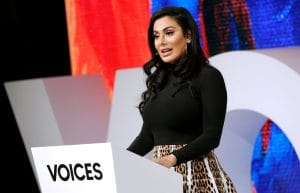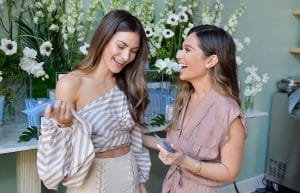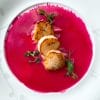Not content with being one the most successful fashion bloggers and influencers of our time, Chiara Ferragni of The Blonde Salad is now breaking into the beauty business too. Having previously played hair ambassador for Pantene, the 31-year-old Italian influencer was last year named Lancôme’s ‘Global Muse’ and recently collaborated with the brand on make-up masterclasses, hosting two ‘Beauty Bites’ events with her personal make-up artist Manuele Mameli.
During the first event, Women’s Wear Daily reported that: “Ferragni revealed ‘there might be surprises this year on the beauty product launch front'” – something that Lancôme didn’t deny when Bazaar reached out for comment.
https://www.instagram.com/p/Bt6P7apFpcT/?utm_source=ig_embed
In America, Lancôme has recently released a collection of lipsticks created with influencer Camila Coelho, so we might expect something in a similar vein from Ferragni, but on a global scale.
https://www.instagram.com/p/BpFFYjcnb3B/?utm_source=ig_embed
While Ferragni and Coelho may be dabbling in collections, fellow mega-influencer Huda Kattan has created one of the biggest cosmetics brands of the moment. Having trained in make-up, Kattan started beauty blogging in 2010 before launching Huda Beauty in 2013. As of 2017 she topped the Instagram Influencer Beauty Rich List, reportedly charging up to $33,000 per post (that’s just over £25,000). Last year Kattan ranked number 37 on Forbes‘s list of America’s Richest Self-Made Women with her brand reportedly bringing in at least $200 million (roughly £155 million) in annual revenue.
Consider such influencer collections on a par with celebrity beauty lines. If Rihanna, Kim Kardashian, Kylie Jenner, Jessica Alba, Drew Barrymore, Miranda Kerr – and now, Victoria Beckham – can be beauty bosses, and fiercely compete with aficionados in the field (from Pat McGrath to Charlotte Tilbury and Anastasia Soare), Kattan proves that so can influencers. All of these entrepreneurs have seen ripe opportunity in the beauty sphere, and, with the megaphone of social media, attracted investors and customers alike.

Huda Kattan speaks on stage during #BoFVOICES, John Phillips Getty Images
Millie Kendall MBE, CEO at the British Beauty Council and director at BeautyMART and its sister PR agency BRANDstand Communcations, tells us that the beauty industry has become so alluring for those from all kinds of backgrounds for many reasons.
You can go in and pull a formula off the shelf now. You don’t have to create it from scratch
“In some ways it’s the entry level: beauty is democratic – you don’t have to have a degree in it or go to school to formulate a product. So it’s quite an even playing field.
“Also, the manufacturers have made it really easy. You can go in and pull a formula off the shelf now. You don’t have to create it from scratch. So that helps!” she says.
On the flip side, Kendall adds, it the news that ‘hey, beauty is valuable!’ – there’s a lot of money to be made in this business with an estimated annual turnover of £18 billion. “People want to spend money on beauty. With the economic climate the way it’s been since pretty much 2008 – i.e. stressful, unpredictable – the investment in beauty has boomed because it’s relatively low in comparison to buying a new car or home, or even an outfit. And that has increased our value.” In addition to the consumer purchasing power, there’s also the fact that you’ve got a lot more people showing their ability to use the product.” Before YouTube and Instagram you didn’t get that inspiration en masse.
Of course, make-up artists were the influencers of Kendall’s youth (hello François Nars, Laura Mercier, Bobbi Brown!), who came with a lot of expertise. On the other side of the social media revolution, the own-brand hustle is also nothing new for those content creators who have a long-standing presence in the beauty sphere. In the UK market, take the Pixiwoo sisters, professional make-up artists and YouTubers, who launched their Real Techniques tools range back in 2011. Or beauty bloggers and YouTubers including Ruth Crilly of A Model Recommends who co-created Colab dry shampoo in 2014, and Tanya Burr, Zoe Sugg (a.k.a Zoella), and Fleur Bell (a.k.a. Fleur de Force) who have all launched eponymous cosmetics lines.
Then there are the collaborations you’ve probably seen all over your feeds: Caroline Hirons, the skincare expert, blogger and YouTuber, has created multiple beauty boxes with retailer Cult Beauty, and more recently with Space NK; her Clean Decoded By Space NK X Caroline Hirons collection is on sale now. She is contracted with beauty brand Pixi, and created its 2-in-1 cleanser, the Pixi + Caroline Hirons Double Cleanse, which remains a permanent fixture in the brand’s skincare offering.
Recently beauty influencer and former beauty director Alessandra Steinherr created a skincare collection for Primark (with some additional releases coming soon). Both Bell and Steinherr were involved in MAC’s first beauty influencer lipstick collection, and Nic and Sam Chapman of Pixiwoo will be the next ‘MAC Makers’, with exclusive lipsticks launching in 2020. (Obviously MAC has a rich history of collaboration with influential personalities, one that pre-dates social media – they’re consistently ahead of the curve).
https://www.instagram.com/p/BtnnP-xAuxm/?utm_source=ig_embed
Frankly, the list of influencer brands collaborations is extensive, and not least with those in the beauty field by association. Companies have tapped personalities that straddle celebrity/influencer status, who look good, have a point of view and boast experience of the industry by way of glam squads and backstage secrets. Take Maybelline and Gigi Hadid who last year launched “three Maybelline make-up collections revealing the story of Gigi Hadid’s life as she sees it”. In a slightly different vein comes Adwoa Aboah and Revlon, who have collaborated on a Gurls Talk collection of colourful make-up kits which shine a light on key women’s issues. Then there’s Becca Cosmetics, partnering with Chrissy Teigen on recurring collections, and recently releasing the Becca X Khloe Kardashian & Malika Haqq collection (Becca also famously collaborated with Jaclyn Hill, who is a make-up artist and YouTuber with her own make-up line rumoured to launch this year). Elsewhere at the Estée Lauder Companies, the successful Victoria Beckham x Estée Lauder capsule collections proved the perfect launchpad for the designer to create her own beauty brand (announced last week). Celebrity endorsement, and involvement, has been a beauty business no-brainer for decades, but increasingly talent are no longer ‘faces’ and storytellers but co-creators, and they’re going alone.
As the above examples, and the Lancôme and Ferragni news highlights, there are now countless beauty brand collaborations with influencers who are less intrinsically linked to the beauty sphere. On a smaller scale take Benefit Cosmetics and Anna Saccone, the lifestyle and motherhood vlogger who currently has a limited-edition brow palette with the brand in the UK; law student turned influencer Diipa Büller-Khosla who has collaborated with MAC on its first influencer travel retail partnership, with her wedding day make-up products being sold at select counters in airports; and blogger-turned-wellness entrepreneur and podcaster Ella Mills of Deliciously Ella who has had two successful product lines with Neal’s Yard Remedies.
“I think that beauty is open to absolutely everybody, it really is,” Kendall tells us of the industry’s democratic nature. “Whether it be a Rihanna or a Victoria Beckham who come in on a slightly different level because they have capital behind them, or a startup, or social media star with one or two products.”
Of course, the revenue speaks for itself – but what these partnerships also really provide for retailers is engagement. When it comes to brand collaborations it’s often a win-win situation. Jessica French, social media and digital engagement manager at Neal’s Yard Remedies tells us that the first skincare collection with Mills, launched in August 2016, was one of their most successful launches to date in terms of press coverage and in-store activity. “Partnering with Ella definitely helped drive a younger audience into our stores: we held in-store customer events/meet and greets which created great theatre. At some of the events, it was the first time that a lot of the attendees had ever been into our store.” Their brand values aligned, she tells us, making it an authentic and organic partnership. The holy grail.
https://www.instagram.com/p/BXkitXFjhOs/?utm_source=ig_embed
One of the most common questions that Ella would receive from her followers was what she used on her skin, French says. “As much as she liked to whizz up her own products in the kitchen or use coconut oil, she wanted to be able to recommend something for on the go, using ingredients she loved.”
French also believes that the draw for influencers goes way beyond the pound signs. “With these collaborations, influencers are able to create so much new and different content for their audience, allowing them to keep their presence fresh and engaging. Content on social channels can be challenging in such a crowded space, and influencer content on a whole is now becoming much more versatile, covering all lifestyle topics: from fashion and beauty, to travel and ethical values. Building these kinds of partnerships also gives them extra levels on which their population are able to identify with them and align themselves to values and beliefs, and therefore show a more holistic image and multi-dimensional view of themselves.”
Influencer beauty brands can be a bit of a minefield
When it comes to standalone brands, Alexia Inge, co-founder of Cult Beauty, points out that “influencer beauty brands can be a bit of a minefield, with wildly varying degrees of quality and involvement”.
However, she holds up two examples as “the gold standard”. She explains, “The first is, of course, Huda Beauty because no matter how big and successful she [Kattan] has become she has never lost the essence of what brought her there… a wonderfully unhealthy obsession with finding the best make-up.” Kattan’s latest venture with Huda Beauty is a collection of false lashes created in collaboration with other influencers (“her main muses,” reads the press release), the first being Bollywood’s most followed sweetheart, Jacqueline Fernandez.
“Then, in skincare, there is Marianna and Lauren of Summer Fridays, who have made ‘slow and steady’ their mantra as they put one year’s worth of work into each product, and boy does it show,” Inge adds. Marianna Hewitt is a German-born fashion, beauty and lifestyle vlogger who was raised between Ohio and Europe, and Lauren Gores Ireland is a former TV anchor-turned-blogger who focuses on motherhood, wellness and beauty out of California. “If you haven’t tried the Summer Fridays Jet Lag Mask, you are in for a huge treat,” Inge tells us.

Marianna Hewitt and Lauren Gores Ireland, Stefanie Keenan Getty Images
The key to success in this space, Inge says, “is caring and authenticity rather than cynical money milking,” because “nowadays the consumer can tell a mile off when it’s the latter”. In terms of collaborations and partnerships, French agrees: “Consumers are becoming much savvier and can see through partnerships that have little or no brand affinity”.
It’s like a bubble that will burst
So, is that what dictates which of these brands will last? “All of these brands will come up and some will float, and some will sink. That’s just a given,” Kendall tells us. “The problem with situations like this is that it’s like a bubble that will burst.”
Kendall’s PR agency specialises in startups, and she says all they ask for is influencer engagement, because they have heard on the grapevine that that’s what drives sales. “Actually, print drives sales,” she says. “A lot of people think they can create a brand and they won’t have to pay anyone to do the publicity for it because they can just put it out on Instagram, connect with lots of people, and sell a lot of it – but there’s a lot of noise on Instagram and a lot of noise on the internet so it’s very, very difficult to get cut-through.” She says for this reason the beauty industry will start to see the fall-out of that in the coming years. “It’s very easy for people to enter. It’s very difficult for people to stay afloat.” Inevitably, the bigger brands like Rihanna’s Fenty and Victoria Beckham Beauty will likely survive, “because they’ve got the most money and the best connections,” but for startups it’s not so easy.
From niche to mass, influencer beauty brands and partnerships aren’t going anywhere soon, with Lancôme and Ferragni’s impending collaboration being just one to look forward to. So, who’s next?
Kendall’s money is on Hannah Martin and Lisa Potter-Dixon. “If somebody doesn’t chuck a load of money at them I’d be very surprised,” she says of the London make-up artists (Martin is a former Bobbi Brown Pro Artist, Potter-Dixon is head make-up artist for Benefit Cosmetics and the two co-host podcast Life and Lipstick). Watch this space.



